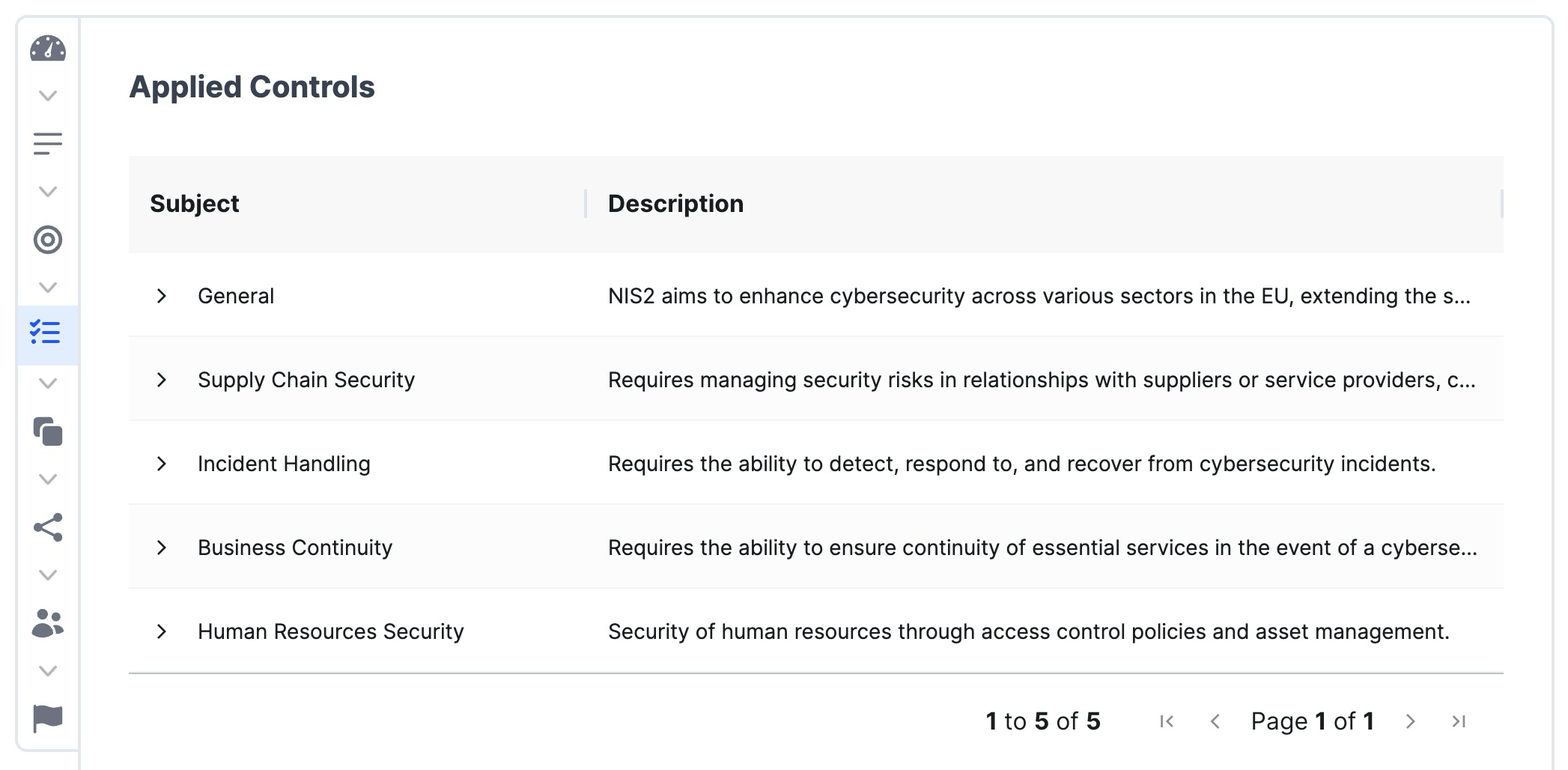Risk Controls

1. Introduction
Each template contains a set of risk controls that have been carefully curated to help manage and mitigate risk within an organization. Risk controls are specific management actions or practices designed to identify, assess, and mitigate potential risks to an acceptable level. These controls play a critical role in identifying and managing risk by proactively addressing vulnerabilities and uncertainties in various aspects of the organization's operations.
By carefully implementing these risk controls, organizations can increase their resilience and minimize the potential negative impact of unforeseen events or disruptions on their overall performance and success.
These controls include a wide range of measures, from supplier evaluation and diversification to contractual agreements and contingency plans, all designed to ensure the integrity and continuity of the supply chain while maintaining operational stability.
2. Application of Risk Controls
Risk Controls are the backbone and are key to effective risk management. Risk Controls are applied in a structured and organized manner to help your company identify, assess and manage risks in your supply chain.
Risk Control are an integral part in the RiskStudio application and are applied to the sub-areas listed below.
Risk identification: In the risk identification process, we focus on accurately identifying potential risks and threats in your supply chain, such as supplier risks, geopolitical risks, quality issues, and operational risks. This identification is the foundation for effective risk management.
Risk assessment: Risk controls go beyond simply identifying risks. We also help you assess the impact and likelihood of identified risks. By determining the severity and priority of each risk, you can more effectively allocate resources to address the most critical threats.
Mitigate risks: Once you've identified and assessed risks, it's time to take action. Risk mitigation involves developing and implementing measures and strategies to reduce or control these risks. This strengthens your supply chain and increases its resilience.
Risk monitoring: Risk controls do not stop after implementation; they are an ongoing process. Risk monitoring involves closely monitoring your supply chain for ongoing risks and taking corrective action when necessary.
3. Risk Control Elements
Risk Controls are carefully housed in structured Risk Templates so that you can easily manage and track your risks. Here are the key elements of a Risk Control:
Unique ID: Each Risk Control has a unique identification number for easy reference and tracking.
Description: A description that explains the Risk Control in detail, including the specific risk being addressed and the proposed action to manage that risk.
Functional Group: This is a classification that subdivides the Risk Control according to the NIST CSF Function categories, making it easier to understand which area the measure applies to.
Reference: A reference to external sources, such as compliance regulations, standards, articles or other documents, which can be used to validate the relevant information.
Severity: The severity of the indicator or risk being addressed by Risk Control. This helps prioritize the measure.
Tier: A classification that indicates at what level of SCRM (Supply Chain Risk Management) the Risk Control applies, for example, strategic, operational or tactical.
Control Question: A set of questions or criteria against which the measure can be assessed to determine if it is adequately implemented and effective in controlling the risk.
4. Frequently Asked Quesiton (FAQs)
Q1: What are Risk Controls and why are they important?
A1: Risk Controls are specific management actions or practices designed to identify, assess, and mitigate potential risks within an organization. They play a critical role in proactively addressing vulnerabilities and uncertainties in various aspects of an organization's operations. By carefully implementing these controls, organizations can increase their resilience and minimize the negative impact of unforeseen events or disruptions.
Q2: How are Risk Controls applied within the application?
A2: Risk Controls are an integral part of the RiskStudio application and are applied in a structured manner:
Risk Identification: In this process, potential risks and threats in your supply chain are accurately identified, such as supplier risks, geopolitical risks, quality issues, and operational risks.
Risk Assessment: Risk Controls go beyond identification by assessing the impact and likelihood of identified risks, helping determine their severity and priority.
Risk Mitigation: After identifying and assessing risks, measures and strategies are developed and implemented to reduce or control these risks, strengthening the supply chain.
Risk Monitoring: Risk Controls are continuously monitored for ongoing risks, with corrective actions taken when necessary.
Q3: What are the key elements of a Risk Control?
A3: Each Risk Control within our application consists of the following elements:
Unique ID: A unique identification number for easy reference and tracking.
Description: Detailed explanation of the Risk Control, including the specific risk it addresses and the proposed action to manage that risk.
Functional Group: A classification based on NIST CSF Function categories to specify the area to which the measure applies.
Reference: Links to external sources like compliance regulations, standards, or articles for validating information.
Severity: Indicates the severity of the risk or indicator being addressed by the Risk Control, aiding in prioritization.
Tier: Classifies the Risk Control's applicability level within SCRM, such as strategic, operational, or tactical.
Control Question: A set of questions or criteria used to assess whether the measure is adequately implemented and effective in controlling the risk.
